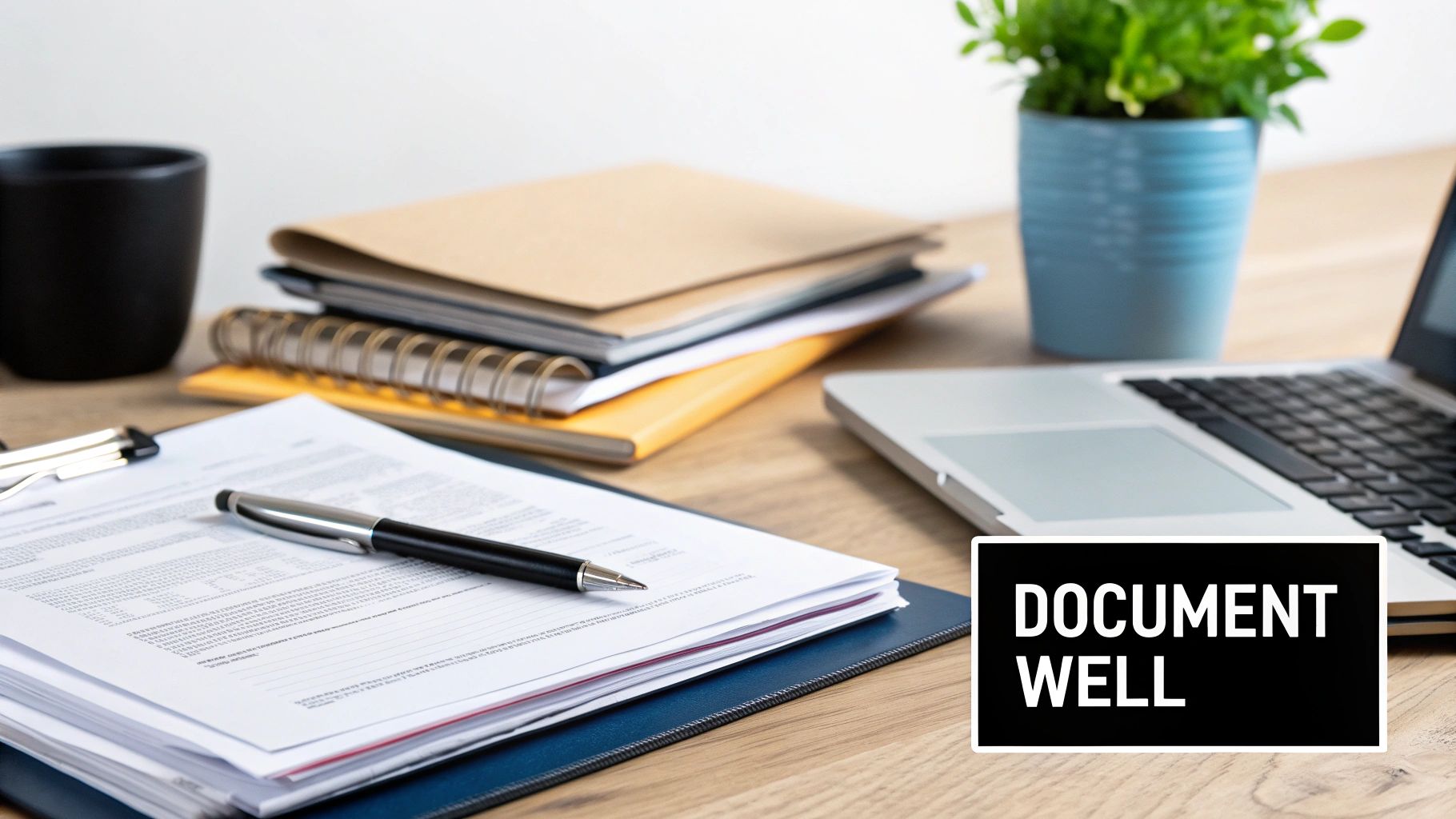Navigating The Car Insurance Claims Maze

Filing a car insurance claim can feel daunting. This section simplifies the process and provides valuable insights into successfully navigating these often complex procedures. The first step is understanding the various types of claims you might encounter.
Understanding Different Claim Types
Several types of car insurance claims exist, each with its own specific characteristics. These differences are important because they directly affect your coverage. Let's explore the key distinctions:
-
Collision Coverage: This covers damage to your vehicle from a collision with another vehicle or object, irrespective of who was at fault. Examples include hitting a deer or backing into a pole. This coverage typically has a deductible.
-
Comprehensive Coverage: This covers damage to your vehicle from events other than collisions, such as theft, vandalism, fire, or weather-related damage. Like collision coverage, it usually includes a deductible.
-
Liability Coverage: This covers damage you cause to another person or their property in an accident where you are at fault. Importantly, it does not cover damage to your own vehicle. Understanding fault determination is crucial here.
Navigating car insurance claims also involves understanding various insurance products. For more information on different types of insurance and how they work, explore additional insurance solutions.
The Claims Evaluation Process
After filing a claim, the insurance company initiates an evaluation process. This process determines the amount the insurer will pay. Adjusters consider several factors:
-
Police reports: These offer an official record of the accident.
-
Witness statements: These corroborate the events and can be incredibly helpful.
-
Vehicle damage assessments: These determine repair costs or the vehicle's value if it's totaled.
-
Medical records: These document injuries and associated expenses.
Historically, car insurance claims exhibit patterns in frequency and type. Collision claims are the most frequent, occurring at an average rate of 5.8 claims per 100 years of insured vehicle coverage. This is followed by property damage claims at 3.7, comprehensive claims at 2.8, and bodily injury claims at 0.95 per 100 car years. More detailed statistics can be found here.
Common Claim Assumptions and Mistakes
Many people approach claims with assumptions that can negatively impact their settlements. For instance, assuming the insurance company is automatically on your side can lead to insufficient documentation and communication. Another frequent mistake is accepting the initial settlement offer without negotiation. Successfully navigating the process requires a proactive and informed approach, ensuring you collect all necessary documentation and understand your rights. This includes understanding the potential long-term consequences of injuries and negotiating for fair compensation. By understanding the nuances of car insurance claims, you can approach the process confidently and secure a just settlement.
Filing Car Insurance Claims That Get Results

The moments following a car accident are critical. What you do and say immediately after the incident can significantly affect the outcome of your insurance claim. Understanding the key steps to take at the scene and how to communicate effectively with your insurance provider is essential.
Documenting the Scene: Essential Steps
Gathering the right information at the scene is paramount to a successful claim. This involves more than simply exchanging insurance details. Thorough documentation is essential for a strong claim.
-
Photographs: Capture images of vehicle damage, the accident scene (including road conditions and traffic signals), and any visible injuries.
-
Witness Information: Obtain the names and contact information of any witnesses. Their statements can support your account of the events.
-
Police Report: A police report provides an official record, even in seemingly minor accidents. This report can prove invaluable to your claim.
These initial actions create a solid foundation for your car insurance claims process.
Reporting the Incident: Using Precise Language
How you report the incident to your insurance company matters. Specific wording can unintentionally jeopardize your claim. Avoid admitting fault or speculating about the cause of the accident.
-
Stick to the Facts: Provide objective details about what occurred, when, and where.
-
Avoid Speculation: Refrain from guessing about the cause of the accident or the extent of the damages.
-
Report Promptly: Contact your insurance company as quickly as possible after the accident. Delays can be problematic.
For example, instead of saying “I think I might have caused the accident,” simply state “My vehicle collided with the other vehicle.” This neutral language protects your interests.
Timing and Communication Strategies
Strategic timing can minimize delays and frustration. Understand the importance of following up and maintaining clear communication throughout the claims process.
-
Confirm Receipt: After filing your claim, verify that your insurance company has received it and understands all the details.
-
Regular Follow-Up: Regularly check in with your claims adjuster for updates and to track the progress of your claim.
-
Keep Records: Meticulously document all communication, including emails, phone calls, and letters.
This organized approach will help keep your claim on track and prevent it from being overlooked.
To help you stay organized, here’s a helpful checklist:
Car Insurance Claims Checklist
Essential steps and information needed when filing a car insurance claim
| Action Required | Timeframe | Tips for Success |
|---|---|---|
| Gather information at the scene (photos, witness info, police report) | Immediately after the accident | Be thorough and document everything |
| Report the incident to your insurance company | As soon as possible | Stick to the facts, avoid speculation |
| Confirm claim receipt with insurer | Within 24-48 hours of filing | Ensure all details are correct |
| Follow up with adjuster | Regularly (e.g., weekly) | Keep a record of communication |
| Organize and index claim evidence | Throughout the process | Chronological order is recommended |
This checklist helps ensure you have all the necessary information and follow best practices when filing a claim.
Organizing Your Claim Evidence
Presenting your evidence clearly and systematically can prevent insurers from undervaluing your claim. Consider it like building a legal case. The stronger your evidence, the stronger your position.
-
Chronological Order: Organize your documents chronologically, beginning with the accident report and concluding with the most recent correspondence.
-
Indexed Documents: Create an index or table of contents for your claim file, making it easy for the adjuster to locate specific information.
This organized approach demonstrates your thoroughness and reinforces the legitimacy of your claim. By focusing on documentation, precise language, strategic communication, and methodical organization, you can greatly improve the likelihood of a successful outcome. This proactive approach empowers you to navigate the claims process effectively and achieve the best possible result.
Overcoming Car Insurance Claims Roadblocks

Insurance companies are businesses. Like any business, managing costs is a primary goal. This can sometimes create obstacles during the car insurance claims process. Understanding these potential roadblocks and employing effective strategies can help you navigate these challenges and reach a fair settlement.
Recognizing Lowball Tactics
A common hurdle is the lowball offer. This is when the insurance company offers a settlement significantly less than the actual claim value. Recognizing this tactic is the first step to overcoming it. These offers often hope you'll accept a quick, but inadequate, payout.
For example, they might undervalue vehicle repair costs or downplay the extent of your injuries. Don't feel pressured to accept the initial offer. Instead, research the actual costs connected to your damages. This research will allow you to counter the lowball offer with solid evidence.
The Power of Documentation
Strong documentation is crucial for car insurance claims. It provides concrete evidence supporting your claim and refutes any insurer arguments. This includes getting multiple repair estimates from reputable shops. You should also gather all medical records and bills, and document any lost wages due to injuries.
Keep records of all communication with the insurance adjuster. This includes emails, letters, and notes from phone calls. Meticulous record-keeping helps demonstrate your claim's true value and push back against lowball tactics.
Navigating Disagreements and Escalation
Disagreements about repair methods, parts quality, or vehicle valuation are common. Presenting documented evidence, like independent appraisals and expert opinions, can be very persuasive. If you can’t resolve the disagreement initially, escalating the issue within the insurance company might be necessary.
This could involve contacting the adjuster's supervisor or filing a formal complaint. The insurance claims services market, which includes car insurance claims, is a large and constantly evolving industry. The market is projected to grow from $184.93 billion in 2024 to $210.11 billion in 2025 at a 13.6% CAGR.
This growth stems from several factors, including a rise in accidents, increasing awareness of risk management, and technological advancements. You can find more detailed statistics here. This market activity highlights how important it is to understand your rights and advocate for yourself during the claims process.
Understanding Your Policy and Leverage Points
Thoroughly review your insurance policy. There are often leverage points adjusters hope you’ll miss. Your policy might include provisions for diminished value, rental car reimbursement, or coverage for specific types of damages. Understanding these provisions strengthens your negotiating position.
This knowledge helps counter the insurance company's arguments and allows you to push for a fairer settlement. Knowledge is power when overcoming car insurance claim roadblocks. By understanding the process, documenting everything, and using available resources, you can increase your chances of a successful claim and a fair settlement. Don't hesitate to seek professional advice if you feel overwhelmed or unsure how to proceed.
Negotiating Car Insurance Claims Like a Pro

Negotiating a car insurance claim effectively can significantly impact your final settlement. It's more than just filing a claim; it's about understanding tactics, documenting your losses, and knowing when to push for more and when to be patient.
Mastering Negotiation Techniques
Negotiating with insurance adjusters requires a strategic approach. Think of it as a chess match: each move should be calculated and purposeful. Start by researching the fair market value of your claim, including vehicle repairs, medical expenses, and other costs. This research is your most powerful tool.
For example, if your car is totaled, research the value of similar vehicles in your area to establish a baseline for negotiation. If you have medical expenses, keep detailed records of every cost associated with your injuries. This provides critical supporting evidence.
Documenting Diminished Value and Ancillary Costs
Beyond immediate repairs and medical bills, consider diminished value. This is the decrease in your car's resale value after repairs, a frequently overlooked loss. Documenting this accurately can significantly boost your settlement. It's like a scratch on a new phone—even repaired, its value is less.
Also, document all ancillary costs such as rental car fees, towing charges, and lost wages. These smaller costs add up and should be included in your claim. They are legitimate losses resulting from the accident.
Let's take a look at how these elements can influence your final settlement. The table below compares typical initial offers with potential final settlements, highlighting key negotiation leverage points:
Car Insurance Claim Settlement Comparison
| Claim Element | Typical Initial Offer | Potential Final Settlement | Negotiation Leverage Points |
|---|---|---|---|
| Vehicle Damage Repair | $2,000 | $2,500 | Comparative repair estimates from multiple certified shops, documentation of pre-accident vehicle condition |
| Diminished Value | $0 | $1,000 | Professional appraisal of diminished value, market analysis of comparable vehicles |
| Medical Expenses | $1,500 | $2,500 | Complete medical records, including doctor's reports, bills, and therapy sessions |
| Lost Wages | $500 | $750 | Employer verification of lost work time, documentation of average daily/weekly earnings |
| Ancillary Costs (rental car, towing) | $200 | $300 | Receipts for all expenses incurred |
This table illustrates how thorough documentation and strategic negotiation can lead to a higher final settlement. Remember, each case is unique, and the potential increase depends on the specifics of your claim.
The Psychology of Timing
Knowing when to negotiate is as important as how. Sometimes, patience yields better results. Waiting until all medical treatments are complete allows for accurate assessment of total medical expenses, avoiding renegotiation later.
However, avoid excessive delays. Be mindful of legal deadlines for filing claims, which vary by state (e.g., Florida). A delayed claim can weaken your position.
Case Studies: Turning Tactics into Triumphs
Real-world examples illustrate the power of negotiation. In one case, an initial offer of $5,000 became a $7,500 settlement—a 50% increase—through meticulous documentation of diminished value and strong evidence of the other driver’s fault.
This highlights the importance of preparation and persistence. Proper documentation and clear communication are essential.
Evaluating Settlement Offers
Before accepting any offer, evaluate it against market standards and your documented losses. Does the offer cover all losses, including diminished value and pain and suffering? If not, keep negotiating.
Think of it like buying a house: you wouldn't accept the first offer without considering comparable properties and negotiating a fair price. Apply the same principle to your insurance claim. By understanding negotiation techniques, documenting losses thoroughly, and understanding the importance of timing, you can negotiate your claim effectively and secure a fair settlement.
Leveraging Technology in Car Insurance Claims
Technology has dramatically changed the landscape of car insurance claims. This presents both opportunities and challenges for those involved. Understanding how to effectively use technology can significantly impact the outcome of a claim. This involves using digital tools to strengthen your case and navigating the complexities of insurers' digital systems.
Using Technology to Strengthen Your Claim
Today's drivers have access to a range of tools to document accidents and gather evidence. Smartphones, dashcams, and even telematics devices play a key role in building a strong claim. For instance, using your smartphone to capture photos and videos at the scene can document vehicle damage, road conditions, and vehicle positions. This digital record can prove invaluable when filing a claim.
Dashcam footage offers a clear, unbiased account of events before, during, and after an accident. This visual evidence can be particularly helpful in resolving disputes about fault. Furthermore, telematics devices and apps can provide data on speed, braking, and location, corroborating your version of events.
Securing and Presenting Electronic Evidence
Gathering digital evidence is just the first step. Knowing how to secure and present it effectively is equally important. Store your photos, videos, and telematics data securely in the cloud service, like Google Drive or Dropbox, and on multiple devices to create backups. This redundancy safeguards against data loss. When submitting evidence, ensure it's well-organized and clearly labeled for the insurance adjuster.
A concise and well-structured presentation enhances your credibility and allows the adjuster to quickly understand the key aspects of your claim. Present the information clearly and concisely, much like a compelling presentation. The growing car insurance market further highlights the importance of effective claims management. The global market, valued at approximately $910.9 billion in 2023, is projected to reach $1,728.96 billion by 2032, with a CAGR of 7.38%. More detailed statistics are available here.
Navigating Insurers' Digital Systems
Many insurers now use online portals and mobile apps for claims reporting and tracking. While these systems offer convenience, understanding their limitations is crucial. Online systems can streamline the initial reporting process, but it's important to supplement them with direct communication with your adjuster.
Personal interaction ensures your claim receives proper attention. Regularly monitor your claim's progress through the online portal and maintain detailed records of all digital correspondence. This proactive approach helps hold the insurer accountable and minimizes potential delays.
The Limits of Automation
While technology can expedite claims processing, it’s essential to recognize the limitations of automated claims assessment. Algorithms may not always account for the unique circumstances of each accident. If your claim involves complex factors or significant damages, advocate for a review by a human adjuster.
This ensures a more thorough evaluation. Don't hesitate to challenge automated decisions that seem unfair or inaccurate. A human adjuster can provide a more nuanced assessment, considering all aspects, including pain and suffering, potentially overlooked by an algorithm. By understanding both the advantages and limitations of technology in car insurance claims, you can effectively manage the process and improve the likelihood of a positive outcome.
Preventing Car Insurance Claims Rejection
The best way to handle a car insurance claim is to be prepared before an accident happens. A proactive approach to policy management and documentation can significantly impact your claim's success. Think of claims not as a reaction to an incident, but as an integral part of your overall car insurance strategy.
Building a Strong Foundation: Documentation and Policy Management
Just as a solid house needs a strong foundation, a successful claim needs careful preparation. Maintaining detailed vehicle records is paramount. These records should document any pre-existing damage, modifications, or repairs. This documentation helps prevent disputes about the vehicle's condition before the accident, much like having a "before" photo in a home renovation project.
Additionally, regularly review your car insurance policy. Familiarize yourself with your coverage limits, deductibles, and any specific exclusions or endorsements. This proactive approach helps avoid surprises when filing a claim and ensures you have the right coverage for your needs.
The Importance of Policy Endorsements and Coverage Verification
Many drivers overlook policy endorsements, additions to a standard policy providing extra coverage. For example, if you’ve added expensive modifications to your car, an endorsement can ensure these upgrades are covered in an accident. Think of it like adding a rider to a homeowner’s insurance policy for valuable jewelry.
Furthermore, verifying your coverage before you need it is crucial. Don't simply assume you're covered. Contact your insurance provider to confirm your policy is active and up-to-date, especially before long trips. This simple step can prevent significant headaches later.
Routine Policy Reviews: Avoiding Coverage Gaps
Life changes, such as buying a new car or moving to a different state, can affect your insurance needs. Regularly review your policy, ideally annually, to ensure it aligns with your current situation. If your commute increases significantly, for example, you might need to adjust your coverage.
This ongoing review helps identify and address potential coverage gaps before you need to file a claim. It’s similar to getting regular checkups with your doctor to catch potential health issues early. By addressing these factors proactively, you create a solid base for successful claims, minimizing the risk of rejection and maximizing your potential compensation. This proactive approach can save you considerable time, money, and stress in the long run. Remember, preventing claim rejection begins long before an accident occurs.
Article created using Outrank
Comments are closed.